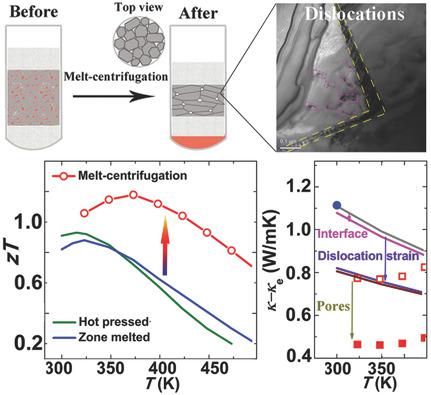当前位置:
X-MOL 学术
›
Adv. Mater.
›
论文详情
Our official English website, www.x-mol.net, welcomes your
feedback! (Note: you will need to create a separate account there.)
Melt‐Centrifuged (Bi,Sb)2Te3: Engineering Microstructure toward High Thermoelectric Efficiency
Advanced Materials ( IF 27.4 ) Pub Date : 2018-07-08 , DOI: 10.1002/adma.201802016 Yu Pan 1, 2 , Umut Aydemir 2, 3 , Jann A Grovogui 2 , Ian T Witting 2 , Riley Hanus 2 , Yaobin Xu 2, 4 , Jinsong Wu 2, 4 , Chao-Feng Wu 1 , Fu-Hua Sun 1 , Hua-Lu Zhuang 1 , Jin-Feng Dong 1 , Jing-Feng Li 1 , Vinayak P Dravid 2 , G Jeffrey Snyder 2
Advanced Materials ( IF 27.4 ) Pub Date : 2018-07-08 , DOI: 10.1002/adma.201802016 Yu Pan 1, 2 , Umut Aydemir 2, 3 , Jann A Grovogui 2 , Ian T Witting 2 , Riley Hanus 2 , Yaobin Xu 2, 4 , Jinsong Wu 2, 4 , Chao-Feng Wu 1 , Fu-Hua Sun 1 , Hua-Lu Zhuang 1 , Jin-Feng Dong 1 , Jing-Feng Li 1 , Vinayak P Dravid 2 , G Jeffrey Snyder 2
Affiliation

|
Microstructure engineering is an effective strategy to reduce lattice thermal conductivity (κl) and enhance the thermoelectric figure of merit (zT). Through a new process based on melt‐centrifugation to squeeze out excess eutectic liquid, microstructure modulation is realized to manipulate the formation of dislocations and clean grain boundaries, resulting in a porous network with a platelet structure. In this way, phonon transport is strongly disrupted by a combination of porosity, pore surfaces/junctions, grain boundaries, and lattice dislocations. These collectively result in a ≈60% reduction of κl compared to zone melted ingot, while the charge carriers remain relatively mobile across the liquid‐fused grains. This porous material displays a zT value of 1.2, which is higher than fully dense conventional zone melted ingots and hot pressed (Bi,Sb)2Te3 alloys. A segmented leg of melt‐centrifuged Bi0.5Sb1.5Te3 and Bi0.3Sb1.7Te3 could produce a high device ZT exceeding 1.0 over the whole temperature range of 323–523 K and an efficiency up to 9%. The present work demonstrates a method for synthesizing high‐efficiency porous thermoelectric materials through an unconventional melt‐centrifugation technique.
中文翻译:

熔融离心 (Bi,Sb)2Te3:通过工程微结构实现高热电效率
微结构工程是降低晶格热导率 (κ l ) 和提高热电品质因数 ( zT ) 的有效策略。通过基于熔体离心的新工艺挤出多余的共晶液体,实现微观结构调制以控制位错的形成和清洁晶界,从而形成具有片状结构的多孔网络。通过这种方式,声子传输受到孔隙率、孔隙表面/结、晶界和晶格位错的组合的强烈破坏。与区域熔化铸锭相比,这些共同导致 κ l减少约 60%,而载流子在液体熔合晶粒中保持相对可移动。这种多孔材料的zT值为1.2,高于完全致密的常规区熔铸锭和热压(Bi,Sb) 2 Te 3合金。熔融离心 Bi 0.5 Sb 1.5 Te 3和 Bi 0.3 Sb 1.7 Te 3的分段腿可以在 323-523 K 的整个温度范围内产生超过 1.0 的高器件ZT ,效率高达 9%。目前的工作展示了一种通过非常规熔融离心技术合成高效多孔热电材料的方法。
更新日期:2018-07-08
中文翻译:

熔融离心 (Bi,Sb)2Te3:通过工程微结构实现高热电效率
微结构工程是降低晶格热导率 (κ l ) 和提高热电品质因数 ( zT ) 的有效策略。通过基于熔体离心的新工艺挤出多余的共晶液体,实现微观结构调制以控制位错的形成和清洁晶界,从而形成具有片状结构的多孔网络。通过这种方式,声子传输受到孔隙率、孔隙表面/结、晶界和晶格位错的组合的强烈破坏。与区域熔化铸锭相比,这些共同导致 κ l减少约 60%,而载流子在液体熔合晶粒中保持相对可移动。这种多孔材料的zT值为1.2,高于完全致密的常规区熔铸锭和热压(Bi,Sb) 2 Te 3合金。熔融离心 Bi 0.5 Sb 1.5 Te 3和 Bi 0.3 Sb 1.7 Te 3的分段腿可以在 323-523 K 的整个温度范围内产生超过 1.0 的高器件ZT ,效率高达 9%。目前的工作展示了一种通过非常规熔融离心技术合成高效多孔热电材料的方法。











































 京公网安备 11010802027423号
京公网安备 11010802027423号